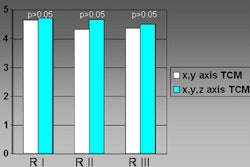SAN FRANCISCO - As the U.S. population continues to age, the demand for colorectal cancer screening intensifies, and screening services must work furiously to keep up. So where should referring physicians look to send their patients, at what time of life, and for what kind of test? A presenter at the American College of Physicians (ACP) meeting discussed the available standard screening tools, as well as how to apply those tools to patients.
"As most of you know, the risk factors of colorectal cancer in the U.S. population are multifactorial," said Dr. Sapna Syngal in a lecture on Friday. "For most people, age is the most common risk factor. After the age of 50, the risk of developing colorectal cancer starts to increase and rises steadily (with) the median age diagnosis in the U.S. of 66 years. For the most part, it is still a cancer of the older population."
Syngal is an assistant professor of medicine at Harvard Medical School in Boston. She is also with the GI Cancer Risk and Prevention Clinic at the Dana Farber Cancer Institute and Brigham and Women's Hospital, both in Boston.
Syngal outlined her strategy for colon cancer screening, starting with a patient risk stratification plan. An average-risk patient would be one who is over age 50 but with no history of disease. However, the ones to keep an eye on are those with a moderate risk (history of adenomas, family history of colorectal cancer) and high risk (familial adenomatous polyposis, hereditary nonpolyposis colorectal cancer). She focused in particular on the latter group with a genetic risk for the disease.
Finally, she shared her opinions on current and future screening methods -- fecal occult blood testing, colonoscopy, genetic testing, and virtual colonoscopy.
Average risk
Syngal recommended that average-risk patients undergo an annual fecal occult blood test (FOBT) plus sigmoidoscopy every five years, double-contrast barium enema every five to 10 years, and colonoscopy every decade. But these methods are far from perfect, either individually or collectively.
She pointed out that FOBT's reported sensitivity rates have ranged from 38% to 57%. "If you have nothing else available, or your patient is not willing to do anything else, this is a good test. It's better than nothing," she said.
While Syngal included double-contrast barium enema on her list, she did question its value, saying the test "remains there for no good reason. It's certainly not the best radiologic test that we have out there.... I think it's less effective and less accurate than virtual colonoscopy. If you really want a radiologic test, this should be replaced by virtual colonoscopy."
As for flexible sigmoidoscopy, its pluses include simple preparation, no sedation, and being readily available as an in-office procedure. On the downside, a patient with positive results must then go on to follow-up colonoscopy. In addition, distal adenomas are not always a good surrogate for proximal neoplasia.
"We have no randomized screening trials on the efficacy of flexible sigmoidoscopy," Syngal said. "The data that we have comes from several good, well-conducted, case-controlled studies that basically showed that the people who developed colon cancer, within the segment that was examined by the sigmoidoscope, had a reduced risk."
Finally, there is colonoscopy every 10 years starting at age 50. The exam is now covered by Medicare -- an obvious advantage. Other benefits include full visualization of the colon and high sensitivity. Disadvantages include IV sedation, full bowel cleansing, and a high complication rate.
However, "the complication rate is probably overblown. The risk of a significant complication is about 0.1%, such as bleeding, perforation, death. Most of those occur when you do something therapeutic, like removing a polyp," Syngal stated.
While screening with colonoscopy is becoming the "bread and butter" of gastroenterology specialists, Syngal cautioned that its efficacy as a primary screening tool remains uncertain as a randomized trial has yet to be done.
Moderate risk
Colorectal cancer surveillance for moderate-risk patients with adenomas may require the removal of all polyps at baseline examination. After that point, three-year intervals between follow-up exams are safe, Syngal said. Surveillance should include clearing colonoscopy both pre- and postoperatively and subsequent colonoscopy at three years.
However, the value of postoperative or post-treatment colonoscopy at six months to a year is controversial, she stated. Studies have indicated that patients with recurring lesions generally have them in other parts of the colon. "The question is, when you have a big lesion that is staring you in the face, should you pay attention to less significant areas and other areas of the colon?"
For those with a moderate risk because of family history, it depends on the family. For someone who is affected by a second-degree relative, his or her risk can be downgraded to average. But a first-degree relative with colon cancer requires surveillance 10 years before the earliest cancer diagnosis, or five years earlier than the earliest adenocarcinoma, Syngal said.
High risk
Two genetic predispositions should send up red flags among healthcare providers: familial adenomatous polyposis (FAP) and hereditary nonpolyposis colorectal cancer (HNPCC).
The clinical features of FAP include a greater than 90% penetrance (the frequency with which a specific phenotype is expressed by those individuals with a specific genotype) for adenomas, a risk of extracolonic tumors, and 100% risk of untreated polyposis leading to cancer.
Syngal suggested that FAP patients with colorectal cancer be managed with an appropriately timed colectomy and surveillance of the rectal segment at least every six months. She pointed out that FAP phenotypes differ within the same family so genetic testing may be required.
For FAP carriers with extracolonic metastases, upper tract surveillance every one to three years with duodenoscopy and biopsy may be required.
Syngal explained that an FAP patient may be the first family member who actually develops the disease thanks to a genetic mutation. "You don't actually have to have the family history to have a patient diagnosed with FAP."
The clinical features of HNPCC include early age at colon cancer diagnosis (around 45 years), multiple primary cancers with the tumor site predominating in the proximal colon, and extracolonic cancers.
Keeping an eye on these genetic carriers includes colonoscopy beginning at age 20-25 and repeated every one to two years. As endometrial cancer is a risk for HNPCC carrier women (a 40% to 60% chance), Syngal recommended transvaginal ultrasound and endometrial aspirate annually, starting at age 25.
For people with the HNPCC, "their cancers occur more rapidly," Syngal said. "That 10-year interval for the sporadic population doesn't apply to these people. What we see as a common management error is telling people to come back in five years. What we see is that while they are waiting for their colonoscopy, they develop interval cancer. You have to survey them much more carefully."
New approaches
In Syngal's estimation, family history is an excellent prescreening tool for people with an inherited risk, as long as it's done thoroughly and correctly. She cited a study that she co-authored, which assessed the quality and impact of family history review (American Journal of Preventive Medicine, October 2004, Vol. 27:3, pp. 239-245).
"It showed that we do reasonably well with obtaining family histories of cancer," she said. "The problem is that even if we get the history, we're not always getting it right. If (a patient) has a cancer in the family, you have to go the next step and ask what age the (relative) was diagnosed at. This is actually going to affect your risk assessment."
She also spoke in conditional favor of virtual colonoscopy. "I think that virtual colonoscopy is rapidly in evolution," she said. "What we need is replication of (study) results."
Citing research from experts such as Dr. Perry Pickhardt, Dr. Judy Yee, and Dr. Peter Cotton, Syngal pointed out the exam has shown a sensitivity of more than 90% for large polyps, although it was less useful for smaller ones (less than 5 mm).
"The radiologic take on small polyps is that we only worry about high-risk polyps," she said. "But I think a big issue is going to be what do you do with those small polyps and how do you follow them?"
Virtual colonoscopy also has a high false-positive rate, Syngal said, turning in a specificity of 75% in one study. "There's no way to tell if something is a stool or a polyp," Syngal said, adding that stool-tagging techniques are currently in progress to address this issue, resulting in higher sensitivity (94%) and specificity (96%). (Software techniques are also becoming available to distinguish polyps from stool.)
In addition, the test is operator-dependent, with a reader variability ranging from 20% to 90%. Patients have expressed reservations about virtual colonoscopy because of the prep, sedation, and air insufflation, she said. Finally, widespread reimbursement is another challenge.
"At Brigham and Women's Hospital, there was lots of enthusiasm for a year or so at offering virtual colonoscopy that rapidly died down when we found out we could not get reimbursed for it. Now we do a preauthorization for anybody who is getting the virtual exam," Syngal said.
As all these issues are addressed, Syngal said virtual colonoscopy will become the gold standard. "In about five to 10 years, I think virtual colonoscopy is going to be the primary screening tool for most individuals."
As for stool DNA testing, Syngal said it currently has limited sensitivity for detecting cancers in comparison to radiologic screening. However, it has shown an improved performance for finding adenomas. In a recent study, stool DNA testing turned in a sensitivity of 52% and a specificity of 95% (New England Journal of Medicine, December 23, 2004, Vol. 351:26, pp. 2704-2714).
An ACP attendee asked Syngal about the cutoff criteria for halting colon cancer screening. One audience member said he stops after age 80, while another said he no longer offered it to patients who have a life expectancy of less than 10 years.
"It depends on who you have in front of you," Syngal said. "There are 60-year-olds that I wouldn't touch with a colonoscope, and there are 90-year-olds and it might make sense. Using that general life expectancy rule of less than 10 years probably does make sense. But it depends on the risk factors of that individual patient."
Syngal stressed to her audience that, unlike other diseases, colorectal cancer risks are modifiable by implementing a screening program.
"If you think about all the other cancers for which screening is offered, there are very few cancers that we actually have a preventable screening test for," she said. "Colon cancer screening is completely different from breast cancer screening or (prostate) testing, which are really focused on early cancer detection.... What you are doing with colon cancer screening is looking for the preventable lesion. I think that will help get people to the screening test that they need."
By Shalmali Pal
AuntMinnie.com staff writer
April 18, 2005
Related Reading
VC with contrast finds more extracolonic trouble, April 11, 2005
Primary care measures boost colorectal cancer screening, April 11, 2005
Men more likely to be screened for prostate cancer than colon cancer, March 8, 2005
Fecal DNA test promising for colorectal cancer detection, December 24, 2004
Copyright © 2005 AuntMinnie.com



















